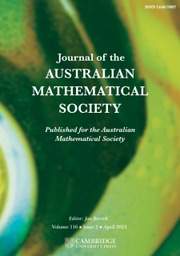Crossref Citations
This article has been cited by the following publications. This list is generated based on data provided by
Crossref.
Prabhu, N. U.
1964.
Time-dependent results in storage theory.
Journal of Applied Probability,
Vol. 1,
Issue. 1,
p.
1.
Prabhu, N. U.
1964.
Time-dependent results in storage theory.
Journal of Applied Probability,
Vol. 1,
Issue. 1,
p.
1.
Prabhu, N. U.
and
Rubinovitch, Michael
1970.
On a Regenerative Phenomenon Occurring in a Storage Model.
Journal of the Royal Statistical Society Series B: Statistical Methodology,
Vol. 32,
Issue. 3,
p.
354.
Kingman, J. F. C.
1973.
Homecomings of Markov processes.
Advances in Applied Probability,
Vol. 5,
Issue. 1,
p.
66.
Kingman, J. F. C.
1973.
Homecomings of Markov processes.
Advances in Applied Probability,
Vol. 5,
Issue. 1,
p.
66.
Iosifescu, M.
and
Tăutu, P.
1973.
Stochastic processes and applications in biology and medicine I.
Vol. 3,
Issue. ,
p.
163.
Grinstein, Jacob
and
Rubinovitch, Michael
1974.
Queues with random service output: the case of Poisson arrivals.
Journal of Applied Probability,
Vol. 11,
Issue. 04,
p.
771.
Grinstein, Jacob
and
Rubinovitch, Michael
1974.
Queues with random service output: the case of Poisson arrivals.
Journal of Applied Probability,
Vol. 11,
Issue. 4,
p.
771.
Kovalenko, I. N.
1974.
Queueing theory.
Journal of Soviet Mathematics,
Vol. 2,
Issue. 1,
p.
1.
Bingham, N. H.
1975.
Fluctuation theory in continuous time.
Advances in Applied Probability,
Vol. 7,
Issue. 4,
p.
705.
Bingham, N. H.
1975.
Fluctuation theory in continuous time.
Advances in Applied Probability,
Vol. 7,
Issue. 4,
p.
705.
Brockwell, P. J.
Resnick, S. I.
and
Tweedie, R. L.
1982.
Storage processes with general release rule and additive inputs.
Advances in Applied Probability,
Vol. 14,
Issue. 2,
p.
392.
Brockwell, P. J.
Resnick, S. I.
and
Tweedie, R. L.
1982.
Storage processes with general release rule and additive inputs.
Advances in Applied Probability,
Vol. 14,
Issue. 2,
p.
392.
1982.
The Single Server Queue.
Vol. 8,
Issue. ,
p.
667.
Bingham, N. H.
1994.
The work of Lajos Takács on probability theory.
Journal of Applied Probability,
Vol. 31,
Issue. A,
p.
29.
Bingham, N. H.
1994.
The work of Lajos Takács on probability theory.
Journal of Applied Probability,
Vol. 31,
Issue. A,
p.
29.
Pakes, Anthony G.
1996.
A hitting time for Lévy processes, with application to dams and branching processes.
Annales de la Faculté des sciences de Toulouse : Mathématiques,
Vol. 5,
Issue. 3,
p.
521.
Konstantinides, D. G.
and
Prabhu, N. U.
2007.
A two-fluid storage model with Lévy inputs and alternating outputs.
Queueing Systems,
Vol. 55,
Issue. 3,
p.
139.
Brody, Dorje C
Hughston, Lane P
and
Macrina, Andrea
2008.
Dam rain and cumulative gain.
Proceedings of the Royal Society A: Mathematical, Physical and Engineering Sciences,
Vol. 464,
Issue. 2095,
p.
1801.
Starreveld, Nicos
Bekker, Réne
and
Mandjes, Michel
2018.
Occupation times of alternating renewal processes with Lévy applications.
Journal of Applied Probability,
Vol. 55,
Issue. 4,
p.
1287.

